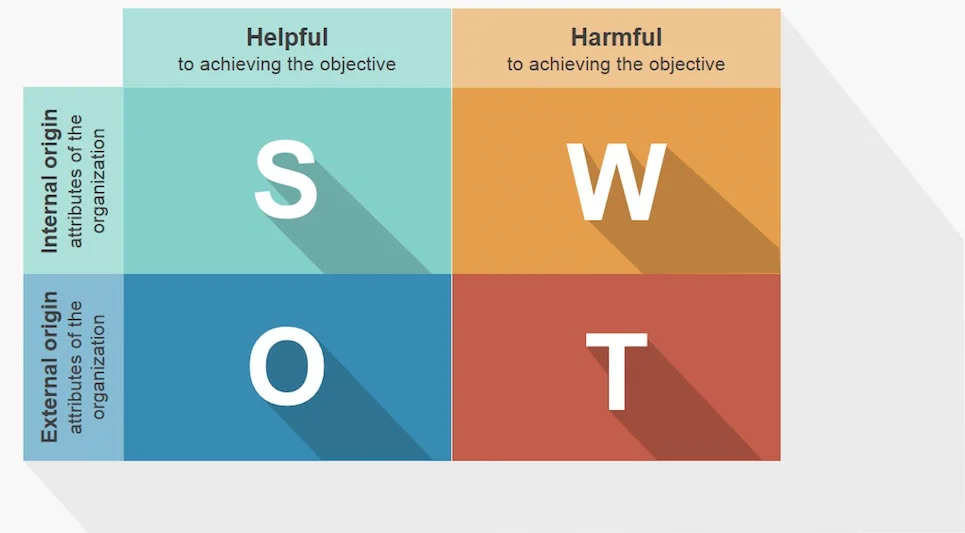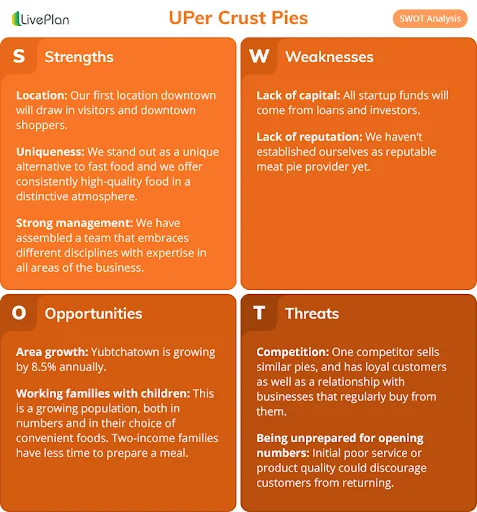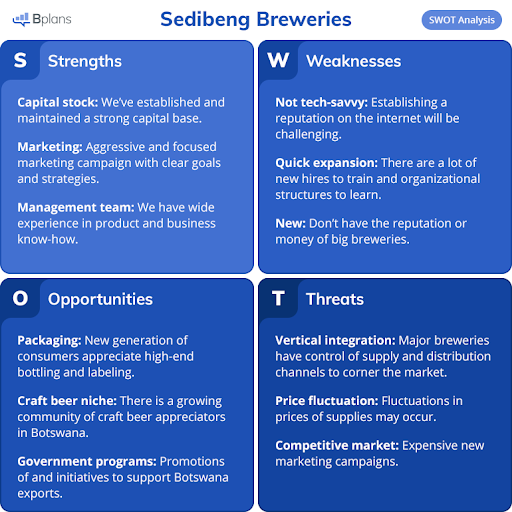In a business context, SWOT analysis is a very powerful analytical technique. It can be used to analyse and understand the current situation of a business. Based on this, you can plan your future strategic moves.
A SWOT analysis can be a powerful tool in the hands of a well-prepared project manager, as it helps to identify opportunities and threats not only at the organisational level but also at the project level.
In fact, we can also talk about a personal SWOT analysis, as this analytical method allows us to identify our own weaknesses and exploit our strengths. It will be of great use in developing our personal brand.
Because of its relatively simple methodology, SWOT is not considered by some to be a real tool, even though it is an essential weapon in strategic planning. The information gained from the analysis can form the basis for improving internal and external processes.
THE ESSENCE OF SWOT ANALYSIS
"SWOT is an analytical technique used to assess the viability of a company, product, idea or project. It maps the strengths, weaknesses, opportunities and threats of the object of analysis. It is a step in the strategy development process."
The name SWOT is made up of the English initials of the four areas covered by the analysis:
- Strengths - strengths
- Weaknesses - weaknesses
- Opportunities - opportunities
- Threats - threats
(In the Hungarian jargon GyELV analysis is also used, see initials of Hungarian words.)
The above four areas are grouped into 2 separate categories in the SWOT analysis:
- Internal factors - we have influence on these. These include strengths (S) and weaknesses (W).
- External factors - we have no direct influence on these because they are outside our control. These are opportunities (O) and threats (T).
This can be visualised in a so-called SWOT table:

It could also be compared to a 4-piece puzzle, where the pieces must be individually interpretable, but because they are closely related, they must be put together to present the whole.
Let's look at the elements one by one.
Strengths
The following questions can help you find the strengths of your business or your project within it:
- What do we do better than the competition?
- What tools do we have that others do not?
- What are the outstanding skills of our team?
- Why do our target audiences like us?
According to SWOT, strengths are internal factors, so we can build on them, plan and build.
Weaknesses
Here we list the negative factors that weaken our strengths. These are worth monitoring constantly.
- Is our team not sufficiently trained, do we need to train them?
- Is the geological location of your business not ideal?
- Do we have internal operational problems?
- Are our staff overworked?
- Is the quality of workmanship deteriorating?
- Why can't we meet the deadlines?
- What usually goes wrong with a deal?
- Poor reputation
- Capital shortage
As these are internal factors, we can and should improve them.
As a simple example, if a significant proportion of our project managers are junior, we can support their development by offering a project manager exam preparation programme and by helping them to achieve the highest professional qualification, Project Management Professional (PMP). We have already done something to minimise the weaknesses in our business.
When listing weaknesses, try to look at them from several angles: perhaps an outside observer can point out weaknesses that we don't immediately see. Don't be afraid to face reality.
Opportunities
External factors in a business area that can potentially contribute to our success. We have no direct control over these, but we can ride them.
- Can we expect market growth in our industry?
- Are there any social or population changes that could be exploited?
- Can we derive any advantage from the latest technological developments and improvements?
Automation is a good example. If it used to take 3 days to complete a task, but now there is the possibility to automate it and complete it in up to 4 hours, it is worth taking advantage of this new opportunity.
Tip: Do not confuse opportunities with weaknesses. This can often happen and cloud our analysis. "Improving internal and customer communication" may sound like an opportunity, but it actually highlights a weakness. Opportunities are an external factor: we have no direct impact on them. But we do have an impact on how our account and project managers communicate with customers. So let's use the term "Inadequate communication" instead and move it to the list of weaknesses.
Threats
Also external elements over which we have no control. For example:
- Growing and increasing competition
- Changing consumer behaviour
- Reduction in supplier capacity
- Labour shortage
- Changes in political and economic conditions
This includes anything that could negatively affect or jeopardise the success of the business or project. But if we consciously prepare for them, we can develop our crisis strategy in advance.
Tip: Do not list internal and external factors based on assumptions, use real data to keep the analysis objective. You can use your own statistics from previous periods, interview your team members and be sure to analyse feedback from your target audience. We also need to consider industry trends and analyse the competition.
Performing a Swot analysis
The steps of the SWOT analysis are:
- Let's formulate the questions to. Some ideas can be found above.
- Sort the answers in the appropriate box of the SWOT matrix, prioritise.
- Let's take action! This is the most important step.
The health check itself does not bring any improvement. Proceed according to the conclusions drawn from the analysis to minimise the weaknesses. And, by consciously avoiding the risks, watch for opportunities.
Example SWOT analysis
Here are some concrete, simple SWOT analysis examples:

Example of a SWOT analysis for a bakery

Example SWOT analysis for a brewery
Source and more examples, SWOT diagrams: bplans.com
SWOT ANALYSIS IN PROJECT MANAGEMENT:
As mentioned above, SWOT analysis can be a useful method not only for developing a corporate strategy. It can also help at project level. The concept is simple: to highlight aspects of the project where success and efficiency can be increased and to find potential pitfalls.
- It is practical to involve most members of the team working on the project in the brainstorming.
- Strive for accuracy, simplicity and transparency.
- The team needs to quickly and clearly understand what the PM has set out as a goal for the analysis.
- Avoid lists that are too long. 10-15 items are enough for a list.
- We prioritise the elements so we can focus on the most important ones.
- Only accurate and as specific as possible, verifiable data should be used in the analysis. For example, instead of using terms such as "good value for money", state precisely that you have an advantage of X HUF over your competitors.
- The chart should be accessible to all. Print it out, send it out by email, put it on the whiteboard, etc.
- Refer to it as a reference so that the team is always clear about the goal.
A SUMMARY OF THE SWOT IN BRIEF:
The SWOT analysis will clearly show that
- What are the main strengths, weaknesses, opportunities and threats of a particular business or project.
- In the light of these, we will see where we can build on and where we need to improve and optimise.
- It provides a direction for development and long-term planning.
- It works for one-person micro-enterprises, as well as for giant companies with hundreds of employees.
- It can be used to investigate a single area of expertise, such as the online marketing of your business.
- We can use it to analyse a competitor or one of our own projects.
- We can use it to assess and improve our own or our colleagues' professional and employee situation.
Tip: In addition to SWOT, all PMs who have attended our project manager training courses learn a range of useful tools and techniques.

 Designabc
Designabc